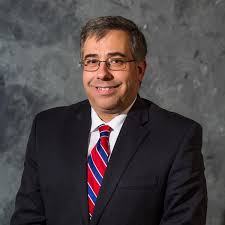Hi, I’m Fred Zaspel – thanks for joining us here at Books At a Glance, and we’re talking again with Dr. Andre Gazal who is sketching out the English Reformation for us in broad strokes. Today, we talk to him about John Jewel.
Andre, who was John Jewel? Tell us briefly about his life and career.
Gazal:
John Jewel was the first major apologist of the Protestant National Church under Elizabeth I, as defined by the Elizabethan Settlement. He was born in Devonshire and in terms of his career, he went to Oxford where he finished both his BA and MA degrees. And as a result of his scholarly distinctives, he rose to the position of Reader of Humanities and Rhetoric at Corpus Christi College. It was while he was at Oxford that he met the reformer, Peter Martyr Vermigli, who had been invited by Cranmer to come to Oxford to become the Regius Professor of Divinity. There, Jewel formed a very, very close relationship with Vermigli that would define his theology and certainly his career in years to come. One of the things that Jewel did was he transcribed Vermigli’s debate at Oxford regarding the meaning of the Eucharist. He also transcribed his lectures on 1 Corinthians while he was there at Oxford, as well.
In the meantime, Edward VI, who was the monarch at the time, died and Mary Tudor ascended to the throne, which placed enormous pressure, as one can imagine, on Protestants. It was no different with Jewel. As the Reader of Humanities and Rhetoric, Jewel was also the official University orator, so he was under obligation to give a celebratory speech commemorating the ascension of Mary Tudor. He was also forced to be a transcriber at the trial of Cranmer, Latimer, and Ridley. After that he was forced to sign certain articles of recantation. Jewel succumbed to pressure, thinking that by doing so he would simply be left alone; but, finding that that was to no avail, he had to resign his readership of Humanities and Rhetoric and eventually fled to the continent to join Peter Martyr Vermigli at Strasburg. Somehow, while in Strasburg, he traveled to Frankfurt and met with the Protestant exiles there and gave a public confession before them in church there, over his having signed these articles of recantation. Really performing a type of public confession, a type of public repentance, if you would, and shortly afterwards he returned to Strasburg with Peter Martyr. He then followed Peter Martyr to Zürich.
One of the chief things that Jewel did while he was in Zürich was that he transcribed Vermigli’s lectures on Judges. In 1558, Mary dies and Elizabeth I comes to the throne. Jewel returns to England to assist in the implementation of the Elizabethan Settlement. It’s in the midst of this that he eventually becomes Bishop of Salisbury; and it’s in that position that he becomes the chief defender of the Protestant National Church as defined by the Elizabethan Settlement before both the English and an international audience, and hence the purpose of his Apology of the Church of England. The Apology of the Church of England is a vindication of the theology and the practice of the Protestant National Church of England as defined by the Elizabethan Settlement in response to the Council of Trent.
Zaspel:
Okay, so it was counter to the counterreformation.
Gazal:
Right.
Zaspel:
Before I let you go, tell us a little bit more about Mary. She has come up in just about every one of our discussions together. This is Bloody Mary. Tell us about the martyrs under her reign. How many were there? Was it extensive? Was it ongoing? Anything you can tell us about that?
Gazal:
From all estimates, from what we understand, probably over 200 Protestants were martyred under her reign. Many of them at Smithfield near London where they would mostly have been burned at the stake. Those that were burned at the stake were usually those who would not recant their Protestant faith. Those that were fortunate enough, fled to the continent and resettled with other Protestants and set up exile communities in places like Geneva, Zürich, and Strasburg.
We can probably say that the persecution under Mary was probably more sporadic than anything else. Yes, it was against the law; yes, she wants to return England to Roman obedience; and she was successful in doing that, momentarily; but it’s interesting though, when you read the work of Eamon Duffy, (now, obviously, Duffy is a Catholic) but when you read the work of Eamon Duffy and other contemporary scholars, the reign of Mary wasn’t the “bloodbath” necessarily, that Foxe and others depicted it to be. But certainly, Protestants perished during her reign. So those of us who share in that heritage dare not minimize that by any means. But her goal was to return England completely and totally to Roman obedience. She would prefer the provinces simply to submit to that, but if not, then certainly she wouldn’t hesitate to enforce the laws against heresy that had been reinstated under her reign.
Zaspel:
We’re talking to Dr. Andre Gazal about the English Reformation. He will be back with us next time, one last time. He will be talking with us then about Richard Hooker. Thanks a lot for joining us.
